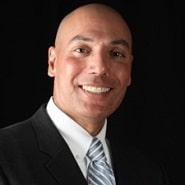
Albert Villarin, MD, CMIO & Associate CIO, Staten Island University Hospital
About a decade ago, healthcare was primarily patient-centric. Now with advances in technology and financial strains on hospitals, we’re seeing healthcare turn the corner to a coordinated care model. The truth is, patients are not being admitted to hospitals like they were before — only the sickest are being admitted, which has reduced income and budgets for many hospitals. How will disruptive technologies provide full patient integration while supporting communication as an inpatient or outpatient practice?
Care coordination among healthcare settings can have a significant impact on patient care. In this model, the patient still remains at the center, but the care is better coordinated among the matrices of clinicians, consultants, and navigators in a holistic way and operates on an active continuum.
Why can’t healthcare be like banking?
As practiced in support of your personal financial transactions, tellers, ATM, business analysts, and loan officers each access your financial records and provide coordinated care for your fiduciary interests. As with personal banking, personalized medical care must move to a collaborative model so the patient is provided concierge services anywhere they may be along the clinical continuum of care. Health services are added or subtracted based upon evidence-based practice, modeled to the patient’s clinical requirements, and monitored by artificial intelligence capable of infinitely complex data comparisons.
To further illustrate this, no single banker has the capability to oversee multiple transactions for multiple clients within multiple financial institutions around the world. A single physician cannot continuously monitor the myriad complex clinical data elements presented by one patient in a large practice across several institutions while simultaneously caring for hundreds of patients on inpatient and outpatient practices. The collaborative care model infuses surveillance, analytics, decision support, and specific alerting to achieve the most appropriate medical interventions when needed.
The challenge is that achieving integrated, comprehensive care is technically complicated, financially demanding, and socially disruptive. Making the transition means that all participants — healthcare providers, payors, pharmaceutical companies, device makers, and new market entrants — will need to collaborate innovatively, share common clinical data, securely exchange data across great distances, all with the trust of patients. With the immersion of social communications standards into clinical practice, current healthcare has undergone a significant technological modernization, changing both the patient and clinician practice model.
Clinical practice is changing more rapidly than physicians can develop practice methods. For instance, diverticulitis, a common illness due to inflammation of the colon, requires antibiotics and potential surgery. A decade ago, it required that patients be admitted to the hospital. Today, it is treated in an ambulatory setting, which has altered clinical caregiver graduate school training, financial reimbursement models, and has driven “treat and release” by EDs more than admissions. In graduate school, advancing technologies have replaced longstanding tools — for example, portable ultrasound replacing the common stethoscope. EDs, driven by evidenced-based guidelines and financial constraints, must retool clinical practice for efficiencies to reduce unnecessary admissions. The challenge is how to coordinate services among healthcare entities that may have divergent interests as it relates to the business of healthcare. We are all now competing for the “patient dollar.”
Collaborative care means collaborative reimbursement, shared within bundled payments and limited by third-party payors. Such restrictions force clinicians and hospital administrators to redesign the patient experience as a continuum of care delivery rather than siloed segments of care; i.e. admission, annual check-up, surgery procedure, etc. Such collaboration provides patients with a single point of access for their entire healthcare experience. Patient portals are the key communications vehicle for modern healthcare and clinical care networks that drive patient access to clinicians and information. By understanding today’s patient expectations, we are obligated to enhance access to information, communication, and immersion of the total patient experience. Coordinating all members of a health network to focus on patient relations through technology should be our common goal.
To achieve this, organizations must collaborate, innovate, and disrupt common ingrained processes and old practices. Current long-standing medical industry silos lead by vertical thinking practitioners, can only promote the same isolation of thought. Through horizontal meta-leadership change, many healthcare networks are beginning to forge partnerships with other players in the healthcare value chain: analytics, genetics, informatics, investors, and national innovators.
This should result in a richer patient profile, with more ubiquitous, clinical, and usable contextual information, ultimately leading to better healthcare outcomes at lower costs. In the same way my money is accessible to me anywhere I determine, so too should my healthcare data be available for use by those who I deem appropriate. Even today, we are seeing that EHR use and patient health data access improve care coordination at a variety of health settings in ways that can have both immediate and lasting impact on patient health outcomes.
The hospitals that succeed today are those that recognize patient satisfaction and positive experiences come from understanding what the patient is going through; not simply checking a box. Patients reflect positively on their hospital stay when they know their providers offered personalized, holistic, quality, empathic, and coordinated care.
As human generational determinants take shape, such as the influences of disruptive technology, social communalism, and willingness to share personal information, healthcare informaticists must be prepared to lead clinical care for the current and next generations. As medical evolution removes antiquated paper processes and provides for secured data exchanges, clinical drivers will provide a roadmap to the future path of clinician care. Applying innovative technology is our responsibility as clinical meta-leaders of change. Such evolution is an opportunity for us to direct the future for our patients and our generations to come.
This piece was written by Albert Villarin, MD, who serves as CMIO of Staten Island University Hospital (part of Northwell Health), and CMIO at Burwood Group. To follow Burwood Group on Twitter, click here.


Share Your Thoughts
You must be logged in to post a comment.